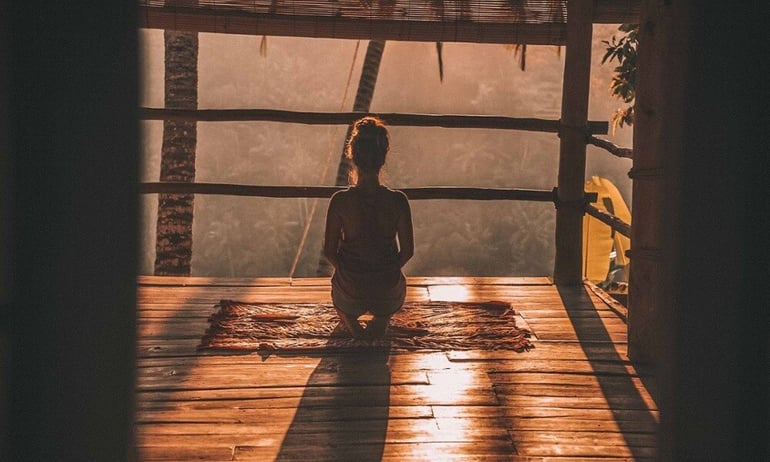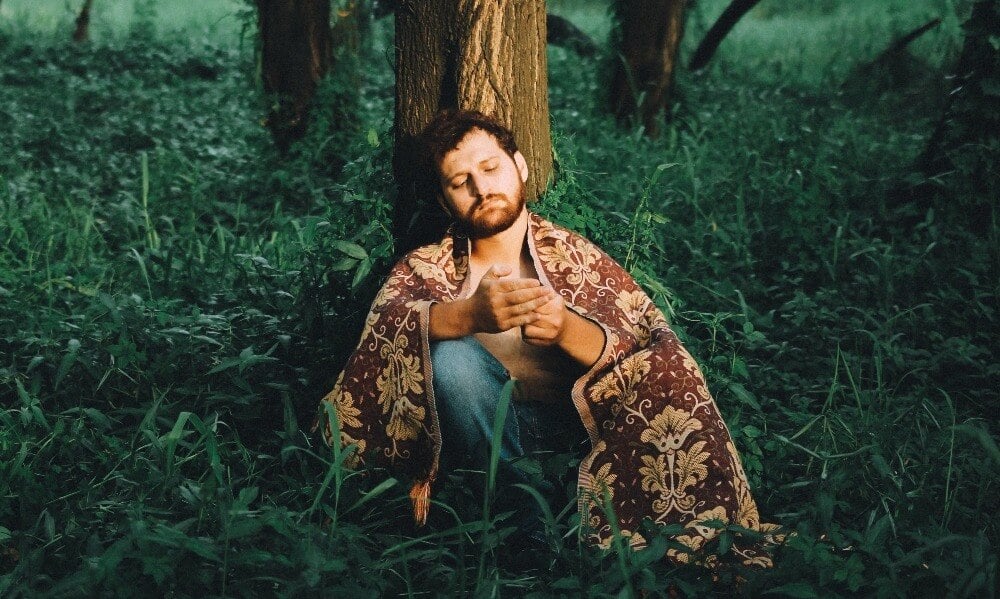Psychedelic breathing, a term often used interchangeably with holotropic breathwork, is a method of controlling your breathing to achieve altered states of consciousness.
By using different breathing techniques, you can enjoy the benefits of psychedelic effects, without taking a psychedelic drug such as ayahuasca or psilocybin.
Many people prefer psychedelic breathing over psychedelics for a variety of reasons. In this article, we are going to delve into what exactly psychedelic breathing is, different breathing techniques you can try out, and the effects and benefits of psychedelic breathing.
What is Psychedelic Breathing?
Psychedelic breathing (or holotropic breathwork) is a way of adjusting your breath so that you enter into an altered state of mind.
Breathwork has its roots in Eastern practices like yoga and Buddhist meditation[*]. People in different cultures have been transforming their consciousness for thousands of years through breathing techniques. The aims of these breathing techniques include meditative relaxation, self-healing, and spiritual awakening.
 It wasn’t until the 1960s and 1970s, however, that Western researchers began to study the therapeutic benefits of psychedelic breathing.
It wasn’t until the 1960s and 1970s, however, that Western researchers began to study the therapeutic benefits of psychedelic breathing. Several types of breathwork arose during this time, including holotropic breathwork and rebirthing breathwork. Some focused on achieving self-awareness, whereas others dealt more with psychedelic effects. We will explore these varieties of breathwork in more depth later on.
The field of breathwork has grown quite a bit since the 70s. In 1991, Jacquelyn Small founded Integrative Breathwork, an approach influenced by Stan Grof’s technique of holotropic breathwork, which Grof developed in the 60s. Clarity Breathwork then emerged in 1999, influenced by rebirthing breathwork, which Leonard Orr devised in the 70s.
Psychedelic breathing has evolved a lot over time, with dozens of models now in existence and many types of breathwork therapists to choose from. There are also various organizations that assist with the training and research of breathwork therapists, such as:
- The Stanislav and Christina Grof Foundation
- Rebirthing Breathwork International (RBI)
- The Global Professional Breathwork Alliance (GPBA)
- The International Breathwork Foundation (IBF)
The Different Types of Psychedelic Breathing

Some of the different types of breathwork include:
- Rebirthing breathwork – practitioners claim this helps you to release suppressed traumatic childhood memories
- Holotropic breathwork – this involves deep, fast breathing to create an altered state of consciousness
- Clarity Breathwork – this aims to achieve the release of stress and emotions
- Vivation – this uses circular breathing to enhance well-being
- Integrative Breathwork – this technique builds on Grof’s holotropic breathing, aiming for holistic healing
The Effects of Psychedelic Breathing
Holotropic breathwork is the type of breathwork that is designed to help you achieve psychedelic effects. Other types of breathwork may lead to psychedelic-like effects, such as changes to emotions and thoughts, as well as alterations in your sense of self and bodily sensations. 
But holotropic breathwork more reliably leads to psychedelic effects. After all, Grof developed this technique so that people could achieve psychedelic states without having to use psychedelics. He developed holotropic breathwork as an alternative to LSD after the substance was banned in the late 60s.
Beneficial Effects
The beneficial effects of psychedelic breathing, such as those brought on by holotropic breathwork, include:- Emotional release, such as through crying or laughter
- Relaxation
- A still, serene state
- Re-experiencing past trauma
- Stress relief
- Insights into personal issues
- Mystical experiences
Potential Risks
Holotropic breathwork and other types of psychedelic breathing involve changes to the balance of oxygen and carbon dioxide. These breathing techniques can involve breathing very fast for long periods of time. This is a controlled, voluntary form of hyperventilation. Hyperventilation occurs when you exhale more than you inhale, producing low levels of carbon dioxide in the blood.Often, this hyperventilation does not cause any issues, but there may be a risk of unpleasant physical sensations and feelings, including lightheadedness, tingles, and other unpleasant physical sensations and emotional experiences. For ordinary, healthy people, psychedelic breathing seems to be low risk. But because of the hyperventilation involved, you should avoid psychedelic breathing if you have a history of any of the following conditions:
- Cardiovascular disease
- Angina
- High blood pressure
- Severe mental illness
- History of panic attacks
- Osteoporosis
- Seizure disorders
- A recent injury or surgery
- Glaucoma
The Effectiveness of Psychedelic Breathing
Psychedelic breathing practitioners claim that psychedelic breathing is helpful in the treatment of many different conditions. Holotropic breathwork, for instance, has been used to treat:- Anxiety
- Stress
- Depression
- Addiction
- Post-traumatic stress disorder (PTSD)
- Trauma
- Chronic pain
- Grief and loss
- Anger issues
- Migraine headaches
But how effective is psychedelic breathing? Can it really be used to alleviate symptoms of all these conditions? There aren’t many studies that demonstrate psychedelic breathing is effective at treating mental health issues like depression and anxiety. However, there are several interesting studies that point to the benefits of psychedelic breathing.

A 1996 study by Sarah Holmes found that participants who received holotropic breathwork treatment plus psychotherapy experienced a reduction in death anxiety and an increase in self-esteem[*]. Also, participants experienced greater benefits than those who received only psychotherapy.
A study conducted by Binovera in 2003 illustrated that participants receiving holotropic breathwork reported improved communication with others, as well as increased insights about the world around them[*].
A 2013 report highlighted that with holotropic breathwork, no adverse reactions were reported by researchers. This report showed, instead, that holotropic breathwork offered people emotional catharsis, making it a low-risk form of therapy.
A 2015 study showed that psychedelic breathing can increase self-awareness and positively shape an individual’s character. Participants reported that these character improvements included being less needy and being slower to anger[*].
Psychedelic Breathing vs. Psychedelic Drugs
Psychedelic breathing differs from psychedelics in many important ways. These differences may make some people prefer psychedelic breathing over psychedelics and vice versa.
Why Some People Prefer Psychedelic Breathing to Psychedelics
For many people, psychedelic breathing is a more attractive option than taking a psychedelic. This is because psychedelic breathing:- Is usually less intense than a psychedelic journey – a ‘bad trip’ is less likely to occur.
- Is more in your control – if you ever feel uneasy, you can bring your breathing back to normal. In contrast, once you take a psychedelic, you can’t stop the experience.
- Is accessible and simple to do.
- Offers some of the therapeutic benefits of psychedelics without some effects you might not want, such as visual or auditory changes, or alterations to your sense of self, time, and space.
- Is shorter-lasting than most psychedelics. A holotropic breathwork session, for example, usually lasts 2 to 3 hours, whereas a mushroom or ayahuasca experience can last around 6 hours.
The Advantages of Psychedelics Over Psychedelic Breathing
There are other reasons, though, why you might think psychedelics are more beneficial than psychedelic breathing:- The evidence for the effectiveness of psychedelic breathing is not as abundant as it is for psychedelics like psilocybin.
- Also, many psychologists have found no evidence supporting specific types of breathwork, such as rebirthing breathwork[*]
- You have an underlying medical condition which makes hyperventilation risky.
- Psychedelics can more reliably induce a mystical experience (this is true when higher doses are involved)
- You want a wide range of psychedelic effects or more intense psychedelic effects.
- You’re looking for long-lasting mental health benefits for depression or another mental health disorder.
Getting Acquainted With Psychedelic Breathing
Like with any potentially psychedelic experience, it’s always recommended that you do psychedelic breathing under the guidance of a facilitator trained in the particular technique you are doing.
This is to ensure the safety and effectiveness of the technique. If you try to do psychedelic breathing on your own, you may put yourself at risk or do the technique wrong or ineffectively, missing out on the therapeutic benefits.
There are different options if you want to experience psychedelic breathing. You can seek out a practitioner of a particular technique, who can provide one-on-one sessions with you. You can also join group sessions.
Some practitioners offer breathwork on its own or they supplement it with other healing modalities, such as psychotherapy. You may find, as many people do, that psychedelic breathing is most effective when combined with other forms of treatment.
Another popular option is to join a retreat. There are retreats featuring psychedelic breathing that can suit your preferences, interests, and needs. You can find retreats that offer different types of breathwork.
Also, some retreats focus exclusively on breathwork, whereas others feature other treatments, including psychedelic sessions, meditation, yoga, and massage.
Psychedelic Breathing is a Low-Risk and Unique Form of Treatment
Psychedelic breathing is unique in that it offers people the benefits of altered states of consciousness, without the need to take any substances. Also, with the help of a trained facilitator, you can achieve an altered state and have cathartic experiences quite easily.
Based on the low risks involved and the fact that breathwork is rarely overwhelming, there is often less nervousness or anxiety before a session compared to taking a psychedelic.
You can try psychedelic breathing on its own or see how it feels to combine it with another form of treatment. Always make sure to engage in psychedelic breathing under the supervision of a licensed, certified facilitator. He or she will be able to help you breathe safely and effectively, as well as work with any material that arises for you during the session.
You may also find a group session useful, as it can foster discussion and a high degree of emotional support.
